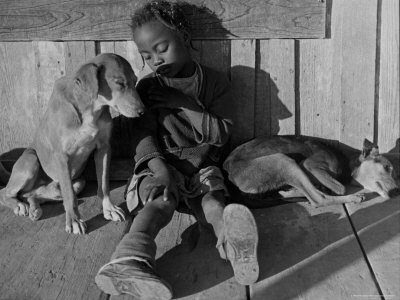
From Mississippi History Now, "Cooperative Farming in Mississippi," by Fred C. Smith: By 1932 the Great Depression had the country in its relentless grip and most Americans believed that something was very wrong.
Children went hungry, adults died of malnutrition, and in the richest agricultural region in the world, the Mississippi River Delta, families survived on the “3-Ms” – meal, meat, and molasses. There were tons of food around, but it was not profitable to transport it, to sell it. American agriculture was booming, yet people were under-fed. Warehouses were full of clothing, yet people were dressed in rags because they could not afford to buy new clothing. The situation was as bleak in the industrial economy as it was in agriculture. Industrial production had fallen by fifty percent.

Sharecroppers suffer
In the 1932 U. S. presidential campaign, New York Governor Franklin D. Roosevelt promised voters he would see to it that Americans got a “New Deal.” Part of the New Deal was a program designed to increase the price of farm products. The Agricultural Adjustment Administration (AAA) program paid farmers to take some land and livestock out of production. While AAA programs helped to rescue large, medium, and even small land-owning farmers, the same program drove poor white and black sharecroppers, the least powerful Americans, to the brink of starvation.
Over eighty percent of the farms in the Lower Mississippi River Delta Region were worked by sharecroppers and over eighty percent of those sharecroppers were black. Sharecroppers did not have money, tools, livestock, or land. Sharecroppers agreed to work the landowner’s land for a share of the proceeds from the sale of the crop. They bought their meal, meat, and molasses on credit from the planter’s commissary or from the local “furnishing” store. Few sharecroppers in the delta region had received cash income from their share of the crop since 1920. Most of them ended the year “in the hole.”

The life of a delta sharecropper was hard. In the 1930s, it got harder. Taking advantage of the government AAA payments, planters soon began evicting sharecroppers, especially their least favorite ones. The least favorite of all sharecroppers were the men and women who had joined the Southern Tenant Farmers Union (STFU). The STFU, which started in Arkansas and spread to other states, attempted to organize black and white tenant farmers into a union in order to get better working conditions and a fair deal in their dealings with the planters.
In late 1935, C. H. Dibble, a planter in Parkin, Arkansas, evicted almost 100 sharecropper families. In March 1936 some of those families made their way to a cooperative farm at Hillhouse, Mississippi, lured by the promise of social equality and economic stability. (source: Mississippi History Now)

No comments:
Post a Comment